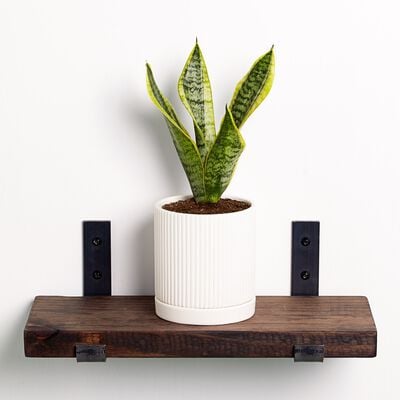
Your Guide To: Snake Plant
Everything you need to know to care for this elegantly elongated plant.
If you're looking for a houseplant that's as stunning to look at as it is simple to care for, the snake plant is The One. With flat, spear-shaped leaves that shoot up in an elegant curve, snake plants add style to any vertical space.
Full-size snake plants can accent coffee tables, side tables, and can even hold their own as a dining room table centerpiece. Shelf-size plants have all the gloss and intricacy of a full-size snake plant, with the bonus of taking up just the right amount of space on bookshelves, kitchen shelves, and windowsills. Snake plants are also fantastic additions to desks, office spaces, and meeting rooms since they don't need daily care or maintenance.
How to Keep a Snake Plant Happy
Snake plants are semi-succulent, which means they can thrive in lots of different light settings and are extremely forgiving of a missed watering or two.
How Much Lighting Does a Snake Plant Need?
How Do I Know When To Water My Snake Plant?
Snake plants are used to a dry climate, which is why they store water in their leaves and roots. For best results, let the soil your snake plant lives in get a little bit dry in between waterings. Test soil by feeling the top two inches with your fingertip (or better yet, take all the guesswork out of watering with a Plant Moisture Indicator from our Accessories shop).
When this soil is dry to the touch, saturate your snake plant’s potting soil with water from a small container or watering can. Pour water out slowly, moving in a clockwise motion so that you can evenly water your plant’s roots.
Any excess water will drip into the tray at the bottom of your plant. Empty that tray within half an hour — snake plant roots can be damaged by sitting in water for too long.

How Do I Use Plant Food for My Snake Plant?
Once your snake plant is settled into its new digs, plant food is an important part of keeping its colors vibrant and leaves upright.
For a shelf-sized snake plant in a container that's between 5 and 6 inches in diameter, insert 3 new plant food spikes (included with your snake plant purchase) into the soil once every month during the spring, summer, and fall. If your snake plant is in a table-sized container (7 to 8 inches in diameter), you'll need 4 plant food spikes. Snake plants are normally dormant during the winter months, so no need to give them plant food during that time.
What Is a Snake Plant's Ideal Environment?
How Do I Prune and Maintain My Snake Plant?
How to Address Common Snake Plant Issues
Most issues with snake plants are due to overwatering or not watering enough. Although they are low-maintenance plants, you still have to be mindful of your watering frequencies.
- Yellowing leaves are a sign that you are overwatering your plant. Wait a while before watering again and prune back leaves that have gone yellow. You may also need to check the roots of the plant for signs of root rot.
- Wrinkly leaves indicate that the moisture in your plant's leaves is drying up and you aren't watering your plant enough. Water thoroughly, then check soil again in a few days to see if you need to water your snake plant again.
- Exposed roots can mean that your snake plant is outgrowing its container.
What to Do If You Still Have Questions
If your snake plant doesn't seem to feel at home in your space, we're here to help! You can chat with a live Greendigs representative on our website. You can also shoot us an email at [email protected].


